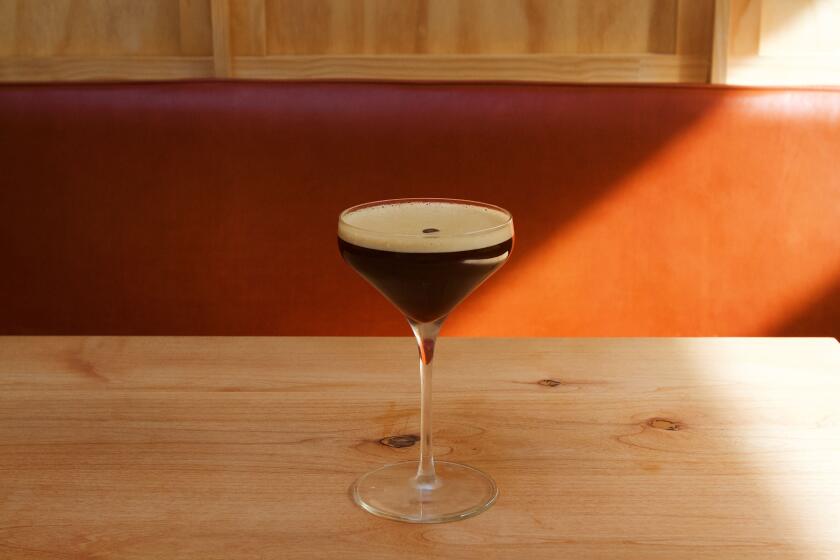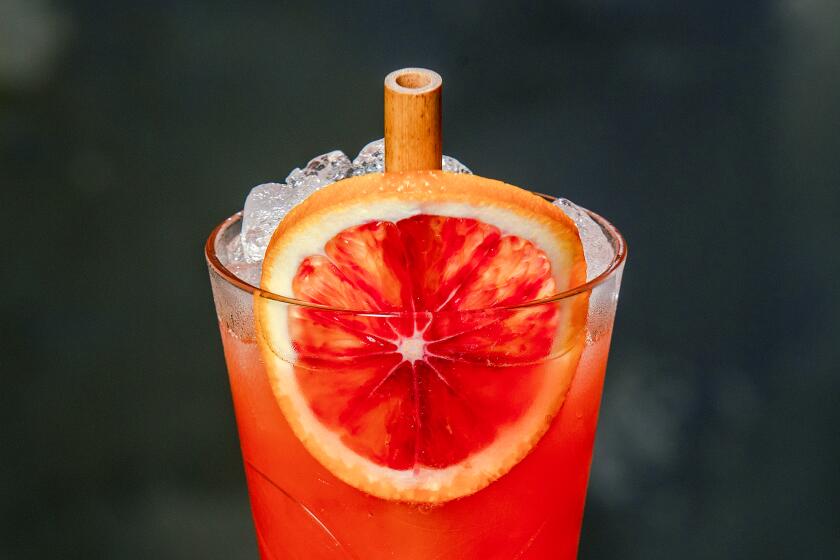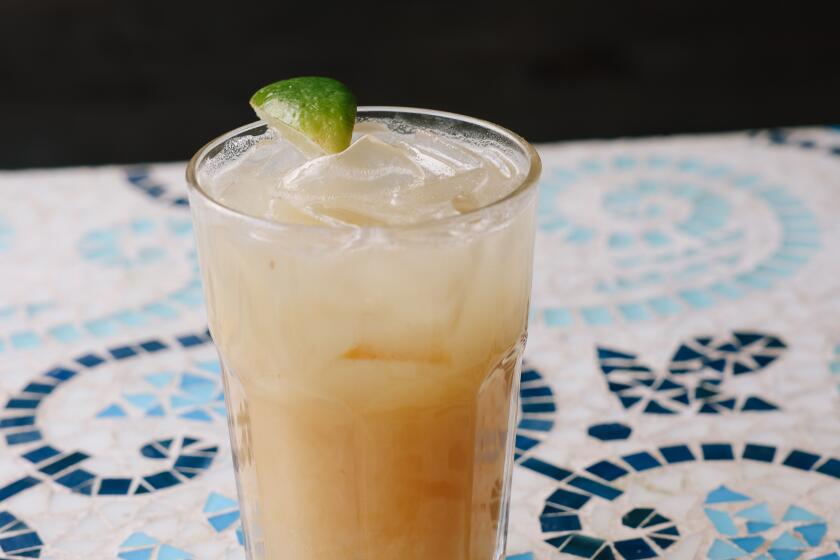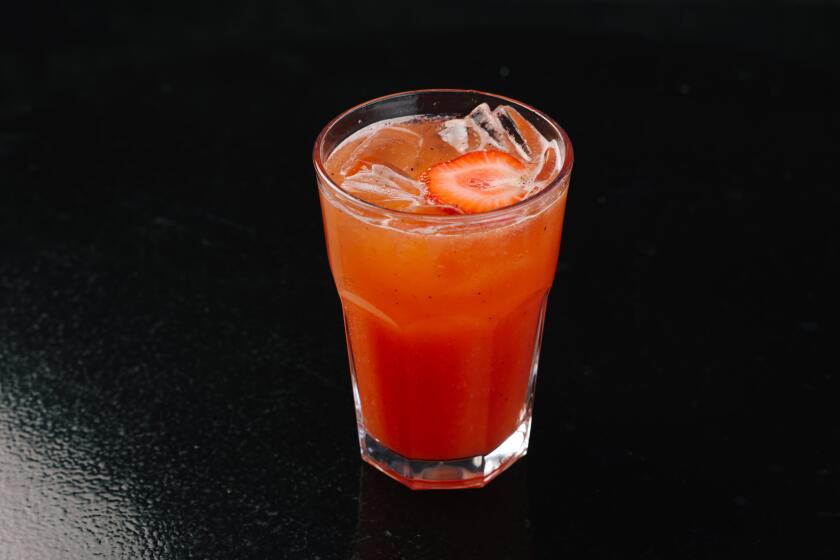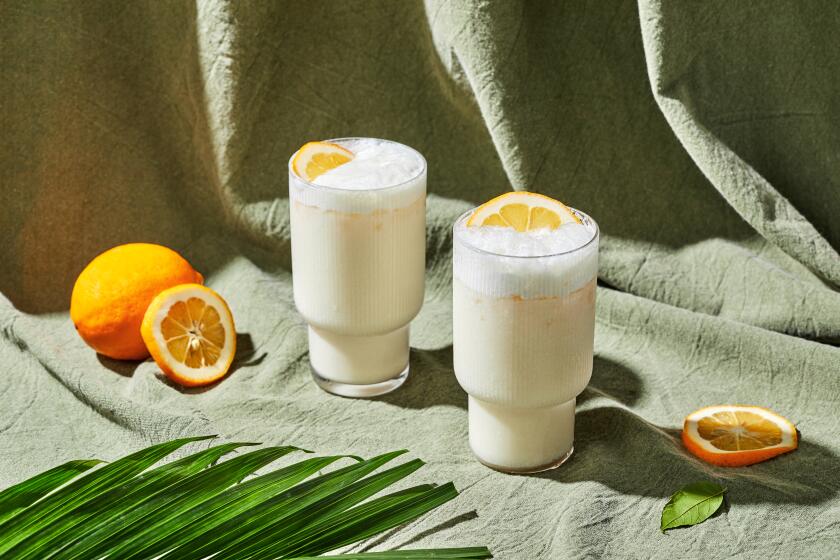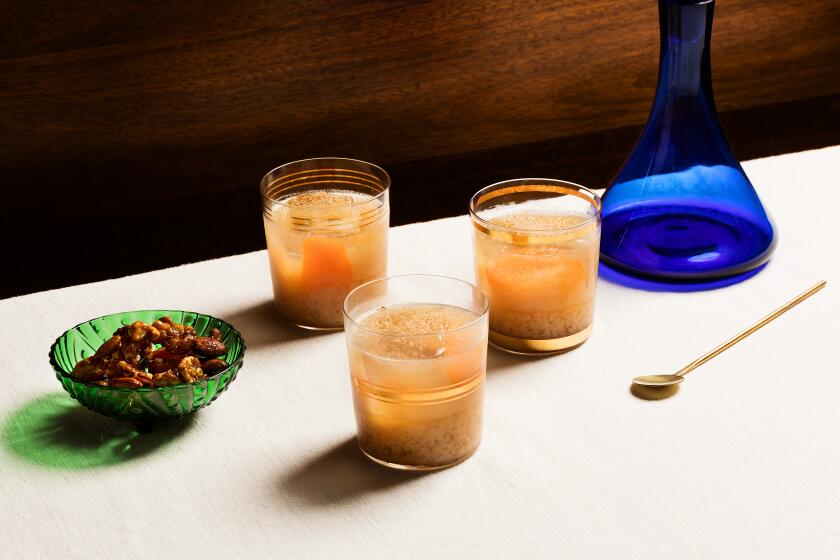Brandy Crusta 21
LAS VEGAS: The name itself evokes the clink of ice in a glass. So it may seem fitting that a museum celebrating the history of the cocktail has just moved into town.
And really, the location couldn’t be better. Visitors to the Museum of the American Cocktail can sip a classic or cutting-edge drink as they check out the collection of historical cocktail memorabilia, because exhibits are on display in a room at Commander’s Palace restaurant in Aladdin Resort & Casino.
Founded in New Orleans, the museum lost its chance for a permanent home there after Katrina, so when the owners of the original New Orleans Commander’s Palace offered space at their Las Vegas branch, the museum founders -- an intrepid band of cocktail professionals, collectors and enthusiasts -- packed up lock, stock and 200-year-old crock jugs and moved into one of the restaurant’s banquet rooms in March.
The site turns out to be ideal because the museum supports and inspires contemporary creative bartending as much as it does the rich and colorful history of cocktails.
Vegas, says museum curator Ted “Dr. Cocktail” Haigh, author of “Vintage Spirits & Forgotten Cocktails,” is “as much now about the culinary and libations industries as gambling. You can get amazing cocktails there.”
Museum visitors can sample original creations concocted by founders, mixologist members and celebrity guest bartenders as they peruse exhibits, attend cocktail-pairing dinners or simply try the monthly special cocktail created specifically for the dinners and classes. (Museum president Dale DeGroff, for example, designed the Caipirinha de Uva, a fruit-forward cocktail of muddled lime and grapes, cachaca and flavored rum in March, and museum member and mixologist-seminar leader Tony Abou-Ganim invented April’s Ginger Mojito, which combines Bacardi Gold Rum, dry ginger ale, fresh ginger-infused syrup, lime juice and fresh spearmint.)
The museum is the brainchild of Jill DeGroff, wife of former Rainbow Room mixologist, author (“The Craft of the Cocktail”) and self-styled “King of Cocktails” Dale DeGroff. One of the centerpieces of the museum’s collection of historical cocktail memorabilia is DeGroff’s 1795 edition of “The Complete Distiller.” Much of the museum’s memorabilia is on loan from Haigh’s personal collection, which includes pricey rooster-shaped shakers and rare pre-Castro Cuban rum.
*
Ambitious outlook
IN addition to the DeGroffs and Haigh, founders and board members include a who’s who of the cocktail world: Jared Brown and Anistatia Miller, authors of “Shaken Not Stirred: A Celebration of the Martini”; Microsoft executive Robert Hess, founder of the cocktail database www.drinkboy.com; writer-historian Phil Greene, a descendant of the New Orleans family that founded Peychaud’s Bitters; and fourth-generation New Orleans barman Chris McMillian.
And the museum is ambitious. Its first American Cocktail Awards ceremony is May 13. Awards will be given in two categories -- aperitif recipes and cocktail menus (actual restaurant and/or bar menus showcasing beverages) -- and will be judged by DeGroff, Hess and Livio Lauro, president of the United States Bartender Guild. Mixologists from around the world are entering recipes. Finalists will be flown to Vegas for a “shake-off”; winners receive gold, silver or bronze olives.
Jacques Bezuidenhout, bar manager of Tres Agaves in San Francisco, has entered two cocktail recipes in the competition: a gin, Campari and passion fruit cocktail named Passion, as well as a Campari and grapefruit cocktail he calls Romanza.
“I love Campari, a spirit that is not used as much anymore,” he says about his entries. “I wanted to enter this contest because I love what they are trying to do with the museum and what it represents.”
That interest in classic ingredients and classic recipes is shared by many of the museum’s supporters. In addition to being the repository for a $250,000 collection of cocktail memorabilia such as vintage shakers and glassware, bottles of rare booze and historic photographs, the museum is a gathering place for professionals and other fine cocktail aficionados. Seminars and demonstrations are held there throughout the year and the museum also cosponsors off-site events at restaurants around the country. Abou-Ganim’s recent seminar on making classic cocktails at home featured recipes with lore and legends, demonstrations, a chance for participants to come up and mix drinks, and sampling.
“We won’t sample all 10 in the course of an hour and a half,” he says, “but maybe four or five.”
The museum exhibit, organized chronologically, displays objects from the earliest days of the cocktail, including a copy of an article from a May 1806 edition of Balance and Columbian Repository, a Hudson, N.Y., newspaper. It’s the first known published definition of “cocktail” and states that such a drink contains four essential ingredients: spirits, bitters, sugar and water.
With books, articles and artifacts, the museum chronicles the cocktail’s rise from working man’s morning pick-me-up to racetrack refreshment enjoyed by wealthy free thinkers. The profession of bartending is documented; a collection of vintage bar guides offers, in addition to drink recipes, nuggets of wisdom on correct bartender conduct such as “cultivate a smiling countenance, study grammar and elocution and don’t wait too long to get married.”
Special exhibits focus on the history of ice, electricity and sugar, all crucial to the cocktail’s evolution. The temperance movement exhibit includes hatchet-shaped Women’s Christian Temperance Movement pins inspired by the eccentric anti-booze crusader Carry A. Nation, who, with her supporters, marched into bars, Bibles in hand, and smashed things with hatchets. Prohibition paraphernalia includes doctors’ prescriptions for liquor, and mail-order whiskey bottles.
ORIGINALLY, whiskey cocktails were the mixed drink of choice for Americans, but shortages of high-quality aged liquor after Prohibition and World War II rationing led to the practice of combining liquor with soda water and ice to make highballs. This, according to Haigh, ushered in a dark period that lasted through the 1970s.
The museum features a large section on the midcentury Martini craze popularized in Vegas by the Rat Pack. However, “the whole Rat Pack thing might have been most people’s image of the cocktail era, but it was, in fact, the end of it -- the thing that killed it,” Haigh says.
“By the ‘60s,” he says, “every cocktail was served on the rocks, including the Martini.”
Gimmickry and prepackaged, artificial ingredients compromised the quality of drinks at many American bars and restaurants. Not until the late ‘80s did the cocktail world start to recover from the era of Harvey Wallbangers and Fuzzy Navels, Haigh says.
But now, he believes, we’re back from the brink, with bartenders reviving classics, making their own bitters and concocting creations with fresh juices and other top-notch ingredients.
“We’re seeing some amazing creativity,” he says. Of course, good liquor helps. “We are in a golden era in terms of the quality of spirits.”
DeGroff agrees. “There’s never been a more interesting time to be in the business. Super premium is the fastest growing segment. Whiskey is back; [there are excellent] single malt Scotches, Bourbons, fine rums.”
The museum, through its seminars, dinners and awards show, showcases the work of contemporary master mixologists. With Commander’s Palace executive chef Carlos H. Gula, DeGroff collaborated on a menu featuring such dishes as Gulf shrimp and Louisiana crawfish paired with a Scotch cocktail called Blood and Sand and Baked Alaska paired with an Espresso Martini; Abou-Ganim did a rum-pairing dinner, offering a classic and original rum-based drinks with each course.
Such concoctions feature fresh fruit purees, imported high-quality cordials, the best liquors and house-made syrups and infusions. The museum focuses attention on and documents how cocktail menus at many restaurants are becoming as sophisticated as wine lists.
“The cocktail as a culinary experience is the best trend today,” Haigh says.
Still, DeGroff believes there’s a long way to go before consumers outside the largest cities become as serious about cocktails as they are about food and wine. Many restaurants are “still a little behind the cutting edge,” he says. “It’s happening, but it’s happening slowly. I go around the country like a missionary trying to get people to use real juices, real recipes, real drinks.”
DeGroff and Haigh hope the museum inspires an appreciation for the cocktail and its colorful history, which might educate consumers to experiment and demand higher quality when ordering. Of course, they’re also hoping people simply drink up and enjoy the collection.
“People are there to have a good time,” said Commander’s Palace co-owner Ti Martin. “With cocktails available, it’s easy to do that.”
Before mixing, prepare a cocktail glass as follows: Rub a slice of lemon around the rim of the glass and dip the glass in superfine sugar so the sugar adheres to the edge of the glass.
Pare half a lemon in a one-piece spiral; arrange the lemon peel spiral to line the inside of the glass.
Fill a small cocktail shaker with one-third cup cracked ice. Add the Cognac, Curacao, maraschino liqueur, lemon juice, simple syrup and bitters. Shake well. Strain into the prepared cocktail glass.
Get our Cooking newsletter.
Your roundup of inspiring recipes and kitchen tricks.
You may occasionally receive promotional content from the Los Angeles Times.










